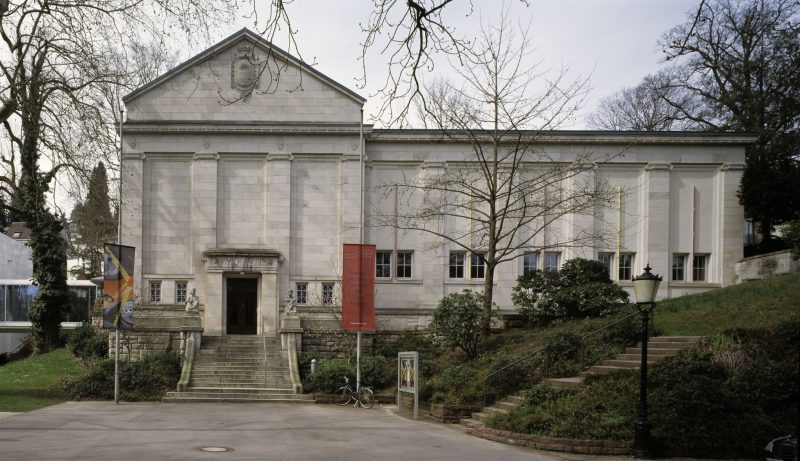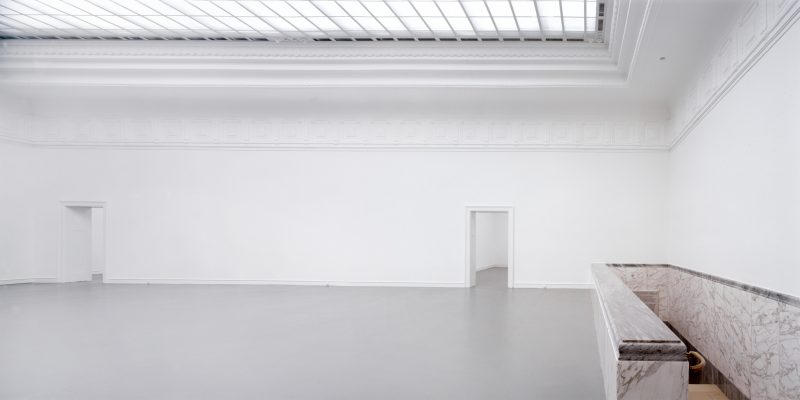History

As an internationally renowned exhibition venue, the Staatliche Kunsthalle Baden-Baden is one of the oldest cultural institutions in the city and the region. It was founded in 1909 as a private institution and transferred to public ownership in 1927. The Kunsthalle is the only one of the eleven state museums that does not have its own collection, but serves solely as an exhibition hall for the presentation of contemporary art on its 672 m² of exhibition space. In 2008, it was converted into a state-owned enterprise in accordance with § 26 of the Regional Budgetary Code (Landeshaushaltsordnung). Since then the Staatliche Kunsthalle Baden-Baden is an institution of the state of Baden-Württemberg under the auspices of the Ministry of Science, Research and the Arts of Baden-Württemberg.
Since its opening as the exhibition hall of the Freie Künstlervereinigung Baden e.V., it has been dedicated to the examination of international contemporary art. Throughout its long history, this mission has been repeatedly renegotiated by the respective directors in office. Since May 2020, Çağla Ilk and Misal Adnan Yıldız have been the directors of the Kunsthalle.
The Kunsthalle was built by the Karlsruhe architect Hermann Billing (1867-1946) and inaugurated in 1909. The building, which appears asymmetrical from the outside, was planned in the late Art Nouveau style and realized at the entrance to Lichtentaler Allee. The architecture and building ornamentation are reminiscent of classical Greco-Roman antiquity.
The Kunsthalle Baden-Baden emerged from a private foundation by the painter and son of the co-founder of the Badische Anilin- & Soda-Fabrik (BASF), Robert Engelhorn, who presented the project of a permanent art exhibition for Baden-Baden in 1906. Herrmann Billing had planned the Kunsthalle from 1906 to 1907 together with his partner Wilhelm Vittali (1859-1920). It was opened in April 1909 with a first exhibition in the presence of Grand Duke Friedrich II. In 1912, the outdoor terraces were built. Herrmann Billing's design initially envisaged a two-winged complex for Baden-Baden. For cost reasons, the building was reduced in size, with the option of building the eastern wing at a later date. The client was the Grand Ducal Ministry of the Interior, and the sponsoring association was the Freie Künstlervereinigung Baden e.V., founded and supported by Engelhorn. In 1927, the Kunsthalle was transferred to state care, and since 2008 the Ministry of Science, Research and the Arts Baden-Württemberg has been the sponsor of the Kunsthalle.
Under the title Ständige Kunstausstellung Baden-Baden (Permanent Art Exhibition Baden-Baden), two exhibitions were usually held each year until the 1930s, partly criticized because of the often above-average participation of members of the Free Artists' Association from neighbouring Karlsruhe. In the summer of 1938 and 1939, the Oberrheinische Kunstausstellung (Upper Rhine Art Exhibition) was organized by the Verein der Kunstfreunde am Oberrhein.
In the course of its history, the Kunsthalle has undergone numerous renovations and constant improvements to its technical equipment. Most recently, in 2004, the Café Kunsthalle was set up in the foyer in parallel with the architectural incorporation of the Frieder Burda Museum.

Originally initiated as an exhibition hall for artists from Baden, the Staatliche Kunsthalle Baden-Baden has developed into an institute of international standing since the late 1950s. The history of the Staatliche Kunsthalle's exhibition activities was strongly characterized by the personalities, professional interests and corresponding thematic emphases of its directors.
Under the direction of Dietrich Mahlow (1957-1967), the Staatliche Kunsthalle became a showcase for world cultures. Exhibitions such as American Ceramics (1960), The Naive Image of the World (1961), Writing and Image (1962/63) or Primitive Textile Weavings from Egypt (1963), alongside countless monographic exhibitions of works from Hans Arp to Jean Tinguely, created a new vision for the museum.
With Klaus Gallwitz (1967-1974), the first blockbuster exhibitions arrived in Baden-Baden: Revolutionary Architecture (1970), Salvador Dalí (1971), Hans Makart (1972) and Russian Realists (1972/73). In the series 14 times 14 (1968-1973), the Staatliche Kunsthalle was offered to the public as an open studio for two weeks at a time. Young artists at the time who today enjoy international fame, including Georg Baselitz, Gerhard Richter, Günther Uecker, Markus Lüpertz and Anselm Kiefer, had their first exhibition here.
Director Hans Albert Peters (1974-1980) presented positions in classical modernism with Juan Gris (1974), Aristide Maillol (1978), Robert Delaunay (1976), Richard Serra (1979) and René Magritte (1976). The Pinacoteca di Brera in Milan was a guest with selected works of 16th to 18th century Northern Italian painting from Bembo to Guardi (1975).
Under the direction of Katharina Schmidt (1980-1985), great interpreters of human existence were discovered: Bruce Nauman (1981), Rebecca Horn (1981), Dani Karavan (1982), Jannis Kounellis (1982), Karel Appel (1982), Cy Twombly (1984). The exhibitions Georges Seurat (1984), Aus der fließend vergänglichen Welt (1984) and Im Schatten hoher Bäume (1985) made institutional history.
As director, Jochen Poetter (1985-1997) documented minimalist strategies that placed architecture in relation to a respective artistic staging, with artists such as Gerhard Merz (1987), Donald Judd (1989), Dan Flavin (1989), Reiner Ruthenbeck (1993) and Richard Tuttle (1993). American artists such as Chuck Close (1994), Alex Katz (1995) and Cindy Sherman (1997) were rediscovered for Germany.
As acting director, Margrit F. Brehm (1997-1999) set the tone with Impressionism and Symbolism - Painting from the Turn of the Century in Poland (1997), Highlights from the Gemeentemuseum Den Haag (1998), Minimal-Maximal (1999), ... on the one hand because of the stars (1999) and solo exhibitions such as Erwin Gross (1997), John Armleder (1998/1999) and Dieter Krieg (1999).
Art served Matthias Winzen (1999-2005) as a means of knowledge in its own right. In trilogies such as Du sollst Dir ein Bild machen (2001/02) and Multiple Räume: Seele - Park - Film (2004/05), under his direction the Kunsthalle gained the profile of a research institute, discussing questions of art's place in life. Exhibitions on Thomas Ruff (2001/02), Georg Herold (2004), Marlene Dumas (2005/06), Thomas Schütte (2006) and Stephan Balkenhol (2006) alternated with thematic insights into private collections.
As acting director, Fritz Emslander (2005-2006) showed treasures of photographic history from hitherto little-known French collections in Tiefenschärfe - Bilder vom Menschen (2006). In Ballerina in a Whirlpool (2006), human structures of perception were examined on the basis of important works of installation art from the Hauser & Wirth Collection. Lost and Found (2006/07) was dedicated to little-known contemporary Hungarian art.
Karola Kraus (2006–2011) focused her special interest on classics of conceptual art in dialog with artistic positions of the 1980s and 1990s. Who's Afraid of Red, Yellow and Blue - Positionen derFarbfeldmalerei, André Cadere - peinture sans fin, Dirk Skreber - Blutgeschwindigkeit, Nairy Baghramian - Walker Day Off, Stephen Prina and Kasimir Malewitsch mark her exhibition activities in 2007/2008.
Johan Holten (2011–2020) curated his first exhibition Taste. The good, the bad and the really expensive in 2011. Numerous solo and group exhibitions followed under his direction: Chto Delat? in Baden-Baden. Das Lehrstück vom Un-Einverständnis (2012), Jacqueline Kennedy Onassis - Eine Romantische Ausstellung von Jan De Cock (2012), Solch ungeahnte Tiefen - Werke von Wangechi Mutu (2012), BILDERBEDARF. Does society need art? (2013), Elizabeth Peyton - Here She Comes Now (2013), AUF ZEIT - Was hinter dem Putz steckt (2013), Macht der Machtlosen (2014), Room Service - Vom Hotel in der Kunst und Künstlern im Hotel (2014), Eva Kot'átková - Experiment für sieben Körperteile (2015), Nach dem frühen Tod (2015), Michael Müller. SKITS. 13 exhibitions in 9 rooms (2016/17), Emeka Ogboh. If Found Please Return to Lagos (2017/18) or Body.Gaze.Power. A cultural history of the bath (2020). He also initiated the project space 45cbm, which was dedicated to projects by young contemporary artists.
Çağla Ilk and Misal Adnan Yıldız took over as joint directors of the Staatliche Kunsthalle Baden-Baden in spring 2020. Since then, they have jointly curated Conditions of a necessity (2020), State and Nature (2021), Cosmos Ottinger (2022), Nature and State (2022), Yvonne Rainer - HELLZAPOPPIN': What about the bees? (2023), Candice Breitz - Whiteface (2023), Jan St. Werner - Space Synthesis (2023), Auditions for An Unwritten Opera (2023) and Sarkis - 7 Tage, 7 Nächte (2023), Opera to a Black Venus (2024), Sea and Fog (2024) and Simurgh (2025). Additionally, they held five editions of the satellite format SYNCH.